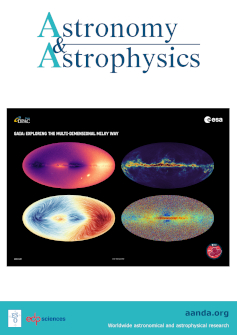The role of the Lorentz force in sunspot equilibrium
IF 5.8
2区 物理与天体物理
Q1 ASTRONOMY & ASTROPHYSICS
引用次数: 0
Abstract
Context. Sunspots survive on the solar surface for timescales ranging from days to months. This requires them to be in an equilibrium involving magnetic fields and hydrodynamic forces. Unfortunately, theoretical models of sunspot equilibrium are very simplified as they assume that spots are static and possess a self-similar and axially symmetric magnetic field. These assumptions neglect the role of small-scale variations of the magnetic field along the azimuthal direction produced by umbral dots, light bridges, penumbral filaments, and so forth.Aims. We aim to study whether sunspot equilibrium is maintained once azimuthal fluctuations in the magnetic field, produced by the sunspot fine structure, are taken into account.Methods. We apply the FIRTEZ Stokes inversion code to spectropolarimetric observations to infer the magnetic and thermodynamic parameters in two sunspots located at the disk center and observed with two different instruments: one observed from the ground with the 1.5-meter German GREGOR Telescope and another with the Japanese spacecraft Hinode. We compare our results with three-dimensional radiative magnetohydrodynamic simulations of a sunspot carried out with the MuRAM code.Results. We infer clear variations in the gas pressure and density of the plasma directly related to fluctuations in the Lorentz force and associated with the filamentary structure in the penumbra. Similar results are obtained in the umbra despite its lack of an observed filamentary structure. Results from the two observed sunspots are in excellent qualitative and quantitative agreement with the numerical simulations.Conclusions. Our results indicate that the magnetic topology of sunspots along the azimuthal direction is very close to magnetohydrostatic equilibrium, thereby helping to explain why sunspots are such long-lived structures capable of surviving on the solar surface for days or even full solar rotations.洛伦兹力在太阳黑子平衡中的作用
上下文。太阳黑子在太阳表面存活的时间从几天到几个月不等。这就要求它们处于磁场和流体动力的平衡状态。不幸的是,太阳黑子平衡的理论模型非常简化,因为它们假设黑子是静态的,并且具有自相似和轴对称的磁场。这些假设忽略了由本影点、光桥、半影细丝等产生的沿方位方向的磁场的小尺度变化的作用。我们的目的是研究一旦考虑到由太阳黑子精细结构引起的磁场方位角波动,是否能保持太阳黑子的平衡。我们将FIRTEZ Stokes反演代码应用于光谱偏振观测,以推断位于盘中心的两个太阳黑子的磁性和热力学参数,并使用两种不同的仪器进行观测:一种是用1.5米德国GREGOR望远镜从地面观测,另一种是用日本的日野号航天器观测。我们将这些结果与用MuRAM代码进行的太阳黑子的三维辐射磁流体动力学模拟进行了比较。我们推断出等离子体的气体压力和密度的变化与洛伦兹力的波动直接相关,并与半影中的丝状结构相关。在本影中也得到了类似的结果,尽管它没有观察到丝状结构。两个观测到的太阳黑子的结果在定性和定量上都与数值模拟非常吻合。我们的研究结果表明,太阳黑子沿方位角方向的磁拓扑结构非常接近磁流体静力平衡,从而有助于解释为什么太阳黑子是如此长寿的结构,能够在太阳表面存活数天甚至整个太阳旋转。
本文章由计算机程序翻译,如有差异,请以英文原文为准。
求助全文
约1分钟内获得全文
求助全文
来源期刊

Astronomy & Astrophysics
地学天文-天文与天体物理
CiteScore
10.20
自引率
27.70%
发文量
2105
审稿时长
1-2 weeks
期刊介绍:
Astronomy & Astrophysics is an international Journal that publishes papers on all aspects of astronomy and astrophysics (theoretical, observational, and instrumental) independently of the techniques used to obtain the results.
 求助内容:
求助内容: 应助结果提醒方式:
应助结果提醒方式:


